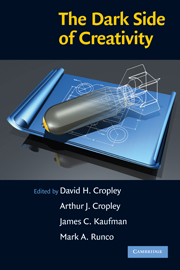Book contents
- Frontmatter
- Contents
- List of Contributors
- 1 The Dark Side of Creativity: What Is It?
- 2 Creativity Has No Dark Side
- 3 Positive Creativity and Negative Creativity (and Unintended Consequences)
- 4 Subjugating the Creative Mind: The Soviet Biological Weapons Program and the Role of the State
- 5 Imagining the Bomb: Robert Oppenheimer, Nuclear Weapons, and the Assimilation of Technological Innovation
- 6 The Innovation Dilemma: Some Risks of Creativity in Strategic Agency
- 7 Early Creativity as a Constraint on Future Achievement
- 8 Boundless Creativity
- 9 Reviewing the Art of Crime: What, If Anything, Do Criminals and Artists/Designers Have in Common?
- 10 Creativity in Confinement
- 11 Creativity and Crime: How Criminals Use Creativity to Succeed
- 12 So You Want to Become a Creative Genius? You Must Be Crazy!
- 13 Both Sides of the Coin? Personality, Deviance, and Creative Behavior
- 14 Neurosis: The Dark Side of Emotional Creativity
- 15 Dangling from a Tassel on the Fabric of Socially Constructed Reality: Reflections on the Creative Writing Process
- 16 Creativity in the Classroom: The Dark Side
- 17 The Dark Side of Creativity and How to Combat It
- 18 A Systems Engineering Approach to Counterterrorism
- 19 Malevolent Innovation: Opposing the Dark Side of Creativity
- 20 Summary – The Dark Side of Creativity: A Differentiated Model
- Index
- References
16 - Creativity in the Classroom: The Dark Side
Published online by Cambridge University Press: 05 June 2012
- Frontmatter
- Contents
- List of Contributors
- 1 The Dark Side of Creativity: What Is It?
- 2 Creativity Has No Dark Side
- 3 Positive Creativity and Negative Creativity (and Unintended Consequences)
- 4 Subjugating the Creative Mind: The Soviet Biological Weapons Program and the Role of the State
- 5 Imagining the Bomb: Robert Oppenheimer, Nuclear Weapons, and the Assimilation of Technological Innovation
- 6 The Innovation Dilemma: Some Risks of Creativity in Strategic Agency
- 7 Early Creativity as a Constraint on Future Achievement
- 8 Boundless Creativity
- 9 Reviewing the Art of Crime: What, If Anything, Do Criminals and Artists/Designers Have in Common?
- 10 Creativity in Confinement
- 11 Creativity and Crime: How Criminals Use Creativity to Succeed
- 12 So You Want to Become a Creative Genius? You Must Be Crazy!
- 13 Both Sides of the Coin? Personality, Deviance, and Creative Behavior
- 14 Neurosis: The Dark Side of Emotional Creativity
- 15 Dangling from a Tassel on the Fabric of Socially Constructed Reality: Reflections on the Creative Writing Process
- 16 Creativity in the Classroom: The Dark Side
- 17 The Dark Side of Creativity and How to Combat It
- 18 A Systems Engineering Approach to Counterterrorism
- 19 Malevolent Innovation: Opposing the Dark Side of Creativity
- 20 Summary – The Dark Side of Creativity: A Differentiated Model
- Index
- References
Summary
TEACHERS' AMBIVALENCE ABOUT CREATIVE CHILDREN
Ng and Smith (2004, p. 87) asked the question at the heart of this chapter: “Why is there a paradox in promoting creativity in the … classroom?” Put simply, the paradox is that most teachers express strong approval of creativity in theory, as already shown over 30 years ago (Feldhusen & Treffinger, 1975) and repeated more recently by Runco, Johnson, and Bear (1993). However, in practice, the situation is different. Although they claim that they enjoy having creative children in their classroom, and indeed, as will be shown below, creative students are often very successful learners, teachers (Dawson, D'Andrea, Affinito, & Westby, 1999)
dislike characteristics associated with creativity and
not seldom express disapproval or even dislike of the students in their classes who are most creative or score highest on creativity tests.
As Westby and Dawson (1995) showed, many teachers who claimed to have a favorable view of creative children almost bizarrely described them as “conforming,” something that Brady (1970) had already reported early in the modern creativity era. As Smith and Carlsson (2006, p. 222) put it, “… teachers seem to have a confused picture of what is a favorite pupil and what is a creative pupil.” When the teachers in the Westby and Dawson (1995) study were given adjectives describing traits more typical of what creative children are really like (e.g., risk-taking, curious), they said that they disliked such youngsters (see also Aljughaiman & Mowrer-Reynolds, 2005).
- Type
- Chapter
- Information
- The Dark Side of Creativity , pp. 297 - 315Publisher: Cambridge University PressPrint publication year: 2010
References
- 11
- Cited by

